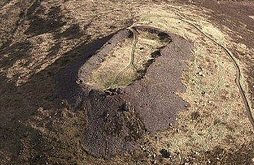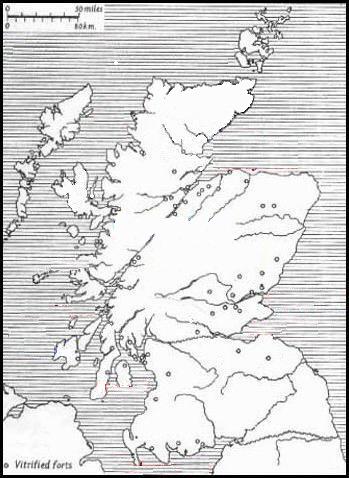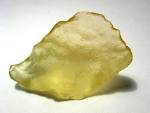|

 Vitrification:
(Ancient Examples of..)
Vitrification:
(Ancient Examples of..)
Vitrification occurs as a result of exposing silica or
stone to extreme heat. The process has been determined at several
ancient sites around
the world. While some can be shown to have been caused naturally, there
have been several recent studies that show it to have been done as a
deliberate act.
Quick-links:
Vitrified ruins have been found Scotland, England, Ireland,
France, Turkey, Iran, Germany and elsewhere, however, out of some 100 forts
identified throughout the world, more than half are located in Scotland.
What is a vitrified Fort?
A Vitrified fort is a 'hill-fort' with stone ramparts/walls
which shows evidence of having been subjected to extreme heats (over 1000˚C),
causing the rocks to melt and fuse together. Although in some cases, this
may have occurred accidentally, but there are several factors which indicate
that it was a deliberate act.
How does Vitrification occur?
There is still some debate over the exact method whereby
such high temperatures were achieved outdoors, but in principle, it is
generally accepted that burning was the method of causing vitrification.
Experiments carried out in the 1930s by the famous
archaeologist V. Gordon Childe and his colleague Wallace Thorneycroft showed
that forts could be set on fire and generate enough heat to vitrify the
stone. In 1934, these two designed a test wall that was 12 feet long, six
feet wide and six feet high, which was built for them at Plean Colliery in
Stirlingshire. They used old fireclay bricks for the faces and pit props as
timber, and filled the cavity between the walls with small cubes of basalt
rubble. They covered the top with turf and then piled about four tons of
scrap timber and brushwood against the walls and set fire to them. Because
of a snowstorm in progress, a strong wind fanned the blazing mixture of wood
and stone so that the inner core did attain some vitrification of the rock
Deliberate Vitrification:
The analysis of vitrified forts
has provided us with enough evidence to show that vitrification, in
most cases at least, was a deliberate act. The following examples
demonstrate.
-
There are some forts which have been placed
on practically infusible rock, such as the quartzose conglomerates of the
Old Red Sandstone, as at Craig Phadraic, and on the limestones of Dun Mac
Uisneachain. In these examples, pieces of fusible rocks have been selected
and carried to the top from a considerable distance demonstrating that the
act of vitrification was deliberate.
-
The vitrified walls of the Scottish forts
are invariably formed of small stones which could be easily acted upon by
fire, whereas the outer ramparts where used, are not vitrified and are built
of large blocks. Many of the continental forts are so constructed that the
fire must have been applied internally, and at the time when the structure
was being erected. Daubr�e, in an analysis which he made on vitrified
materials taken from four French forts, and which he submitted to the
Academy of Paris� in February 1881, found the presence of natron in such
great abundance that he inferred that sea-salt was used to facilitate fusion
again suggesting that it was a deliberate act.
-
Hamilton describes several sites in detail, including
Arka-Unskel, which he found that the rampart of local Gneiss was covered
with imported feldspatic sanstone in order to create the vitrified effect.
This method found also in the vitrified fort of Dun Mac Snuichan, on Loch
Etive.
Examples of Scottish Vitrified Forts.

Location
- Scotland. Ross & Cromarty (Highland region), 2.5 miles west of Dingwall
Description
- The hilltop crowned by this fort is scattered with lumps of vitrified
rock.
Location
- Scotland. Kirkcudbright/Dumfries & Galloway Region, 4 miles south of Dalbeattie
Description
- The fort was first built in the late 'Bronze age' or early 'Iron age', and
finds show that it was in use until the 2nd century AD, iron smelting and metalworking being carried on
there. The site has traces of a massive stone wall, now vitrified.
The following item appeared in
the New York Herald Tribune on February 16, 1947 (and was
repeated by Ivan T. Sanderson in the January 1970 issue of his
magazine, Pursuit):
'When the first atomic bomb exploded in
New Mexico, the desert sand turned to fused green glass. This
fact, according to the magazine Free World, has given certain
archaeologists a turn. They have been digging in the ancient
Euphrates Valley and have uncovered a layer of agrarian culture
8,000 years old, and a layer of herdsman culture much older, and
a still older caveman culture. Recently, they reached another
layer of fused green glass'.
Egyptian Tektites:
One of the strangest mysteries of ancient
Egypt is that of the great glass sheets that were only
discovered in 1932. In December of that year, Patrick Clayton,
a surveyor for the Egyptian Geological Survey, was driving
among the dunes of the Great Sand Sea near the Saad Plateau in
the virtually uninhabited area just north of the south-western
corner of Egypt, when he heard his tyres crunch on something
that wasn't sand. It turned out to be large pieces of
marvelously clear, yellow-green glass.
In fact, this wasn't just any ordinary
glass, but ultra-pure glass that was an astonishing 98 per
cent silica. Clayton wasn't the first person to come across
this field of glass, as various 'prehistoric' hunters and
nomads had obviously also found the now-famous Libyan Desert
Glass (LDG). The glass had been used in the past to make
knives and sharp-edged tools as well as other objects. A
carved scarab of LDG was even found in Tutankhamen's tomb,
indicating that the glass was sometimes used for jewellery.
An article by Giles Wright in the British
science magazine New Scientist (July 10, 1999), entitled
"The Riddle of the Sands", says that LDG is the purest natural
silica glass ever found. Over a thousand tonnes of it are
strewn across hundreds of kilometres of bleak desert. Some of
the chunks weigh 26 kilograms, but most LDG exists in smaller,
angular pieces--looking like shards left when a giant green
bottle was smashed by colossal forces.
According to the article, LDG, pure as
it is, does contain tiny bubbles, white wisps and inky black swirls. The whitish inclusions consist of refractory minerals such as cristobalite. The ink-like swirls, though, are rich in iridium, which is diagnostic of an extraterrestrial impact such as a meteorite or comet, according to conventional wisdom. The general theory is that the glass was created
by the searing, sand-melting impact of a cosmic projectile.
However, there are serious problems with
this theory, says Wright, and many mysteries concerning this stretch of desert containing the pure glass. The main problem: Where did this immense amount of widely dispersed glass shards come from? There is no evidence of an impact crater of any kind; the surface of the Great Sand Sea shows no sign of a giant crater, and neither do microwave probes made deep into the sand by satellite radar.
Libyan Tektites:
An article entitled "Dating the Libyan Desert Silica-Glass"
appeared in the British journal Nature (no. 170) in
1952. Said the author, Kenneth Oakley.
 Pieces of natural silica-glass up to 16 lb in weight
occur scattered sparsely in an oval area, measuring 130 km
north to south and 53 km from east to west, in the Sand Sea of
the Libyan Desert. This remarkable material, which is almost
pure (97 per cent silica), relatively light (sp. gin. 2.21),
clear and yellowish-green in colour, has the qualities of a
gemstone. It was discovered by the Egyptian Survey Expedition
under Mr P.A. Clayton in 1932, and was thoroughly investigated
by Dr L.J. Spencer, who joined a special expedition of the
Survey for this purpose in 1934. Pieces of natural silica-glass up to 16 lb in weight
occur scattered sparsely in an oval area, measuring 130 km
north to south and 53 km from east to west, in the Sand Sea of
the Libyan Desert. This remarkable material, which is almost
pure (97 per cent silica), relatively light (sp. gin. 2.21),
clear and yellowish-green in colour, has the qualities of a
gemstone. It was discovered by the Egyptian Survey Expedition
under Mr P.A. Clayton in 1932, and was thoroughly investigated
by Dr L.J. Spencer, who joined a special expedition of the
Survey for this purpose in 1934.
The pieces are found in sand-free corridors between
north-south dune ridges, about 100 m high and 2-5 km apart.
These corridors or "streets" have a rubbly surface, rather
like that of a "speedway" track, formed by angular gravel and
red loamy weathering debris overlying Nubian sandstone. The
pieces of glass lie on this surface or partly embedded in it.
Only a few small fragments were found below the surface, and
none deeper than about one metre. All the pieces on the
surface have been pitted or smoothed by sand-blast. The
distribution of the glass is patchy.
While undoubtedly natural, the origin of the Libyan
silica-glass is uncertain. In its constitution it resembles
the tektites of supposed cosmic origin, but these are much
smaller. Tektites are usually black, although one variety
found in Bohemia and Moravia and known as moldavite is clear
deep-green. The Libyan silica-glass has also been compared
with the glass formed by the fusion of sand in the heat
generated by the fall of a great meteorite; for example, at
Wabar in Arabia and at Henbury in central Australia.
Reporting the findings of his expedition, Dr Spencer
said that he had not been able to trace the Libyan glass to
any source; no fragments of meteorites or indications of
meteorite craters could be found in the area of its
distribution. He said: "It seemed easier to assume that it had
simply fallen from the sky."
It would be of considerable interest if the time of
origin or arrival of the silica-glass in the Sand Sea could be
determined geologically or archaeologically. Its restriction
to the surface or top layer of a superficial deposit suggests
that it is not of great antiquity from the geological point of
view. On the other hand, it has clearly been there since
prehistoric times. Some of the flakes were submitted to
Egyptologists in Cairo, who regarded them as "late Neolithic
or pre-dynastic".
|